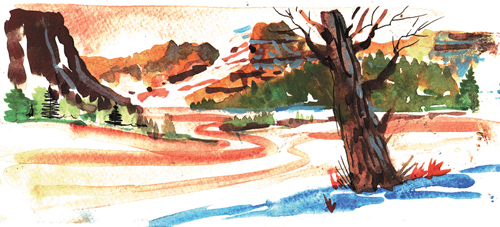Utah’s Coral Pink Dunes a beautiful natural wonder

A four-season recreation area, Utah’s Coral Pink Sand Dunes State Park frequently offers winter visitors the rare experience of playing in sand and snow at the same time. This unique park, located at 6,000 feet elevation, features deep orange-red sand dunes accented by tall Ponderosa pine trees, pinyons and junipers.
To reach Coral Pink Sand Dunes State Park, drive north from Las Vegas 120 miles to St. George, Utah. Watch for the turnoff toward Hurricane on Highway 9 a few miles north of St. George. The state park lies southeast of Zion National Park, a short distance off U.S. Highway 89. Approach it either through Zion or across the Arizona Strip to reach U.S. 89 at Kanab.
Unless you have a federal recreation passes, the route following Highway 9 through Zion involves paying a $25 park entrance fee and an additional $10 fee to go through the Zion tunnels. If you are driving a recreational vehicle or towing a trailer, Highway 9 ends at Mount Carmel Junction on U.S. 89. Coral Pink Sand Dunes State Park is 12 miles south of the junction by way of the northern entrance road.
Most people opt for the other route, which starts in Hurricane on Highway 59, crossing into Arizona on Highway 389 and turning north on U.S. 89A at Fredonia. Drive the few miles north into Utah at Kanab to reach U.S. 89. The state park is 22 miles northwest of Kanab using the southern entrance road.
Established in 1963 as a Utah state park, Coral Pink Sand Dunes preserves more than 3,700 acres of former range land for recreation, including 2,000 acres of sand hills and high dunes. Popular with off-roaders, horseback riders, hikers, campers, wildlife watchers and photographers, the park attracted 56,000 visitors last year. It remains open daily all year with no holiday closures.
The only dune field on the Colorado Plateau and the second highest such area on the continent, the Coral Pink Sand Dunes comprise a unique geological area. The gorgeous sands colored by iron oxide derive from erosion of the vivid Navajo sandstone found throughout Utah’s color country. They arrive grain by grain, wind-borne through a notch to the south between the Moquith and Moccasin mountains. Still growing, the sandy area is now several hundred feet deep.
Near the main park entrance, a tree-shaded area with picnic facilities and a boardwalk trail over the sand invite exploration. Closed to off-road vehicles, this is part of 256 acres set aside for walkers and visitors playing in the sand. Bring the kinds of buckets and spades you would take for the children to play on ocean beaches. In winter, bring along slick-bottomed sliders like toboggans to glide over snow-covered sand hills. Other areas preserved from off-road traffic protect the endangered Coral Pink Tiger beetle, a sub-species found only in these sands.
Utah collects a $6 per vehicle entrance fee at Coral Pink Sand Dunes State Park. Many visitors come just for the day, perhaps picnicking in the park’s five-site picnic area and opting to stay in motels, bed-and-breakfast inns or RV parks in nearby communities.
Others use the park’s 22-site campground or the seven-unit primitive camping area maintained by the Bureau of Land Management just outside the park at Ponderosa Grove. Campsites inside the park are available for $16 a night. Drive-through sites accommodate recreational vehicles up to 40 feet. There are no hookups, but the park has hot showers in the restrooms and an RV dump site.
Campsite reservations are a good idea. Although the park gets fewer visitors in winter than during other seasons, the campground gets busy on holiday weekends. Reserve sites by calling (800) 322-3770.
For more information about the park, call the ranger station at (435) 648-2800 from 8 a.m. to 5 p.m. Mountain time. Ask about upcoming scheduled programs, including astrology sessions. Overnighters at Coral Pink Sand Dunes find the night skies provide a spectacular show.
Margo Bartlett Pesek’s column appears Sundays.